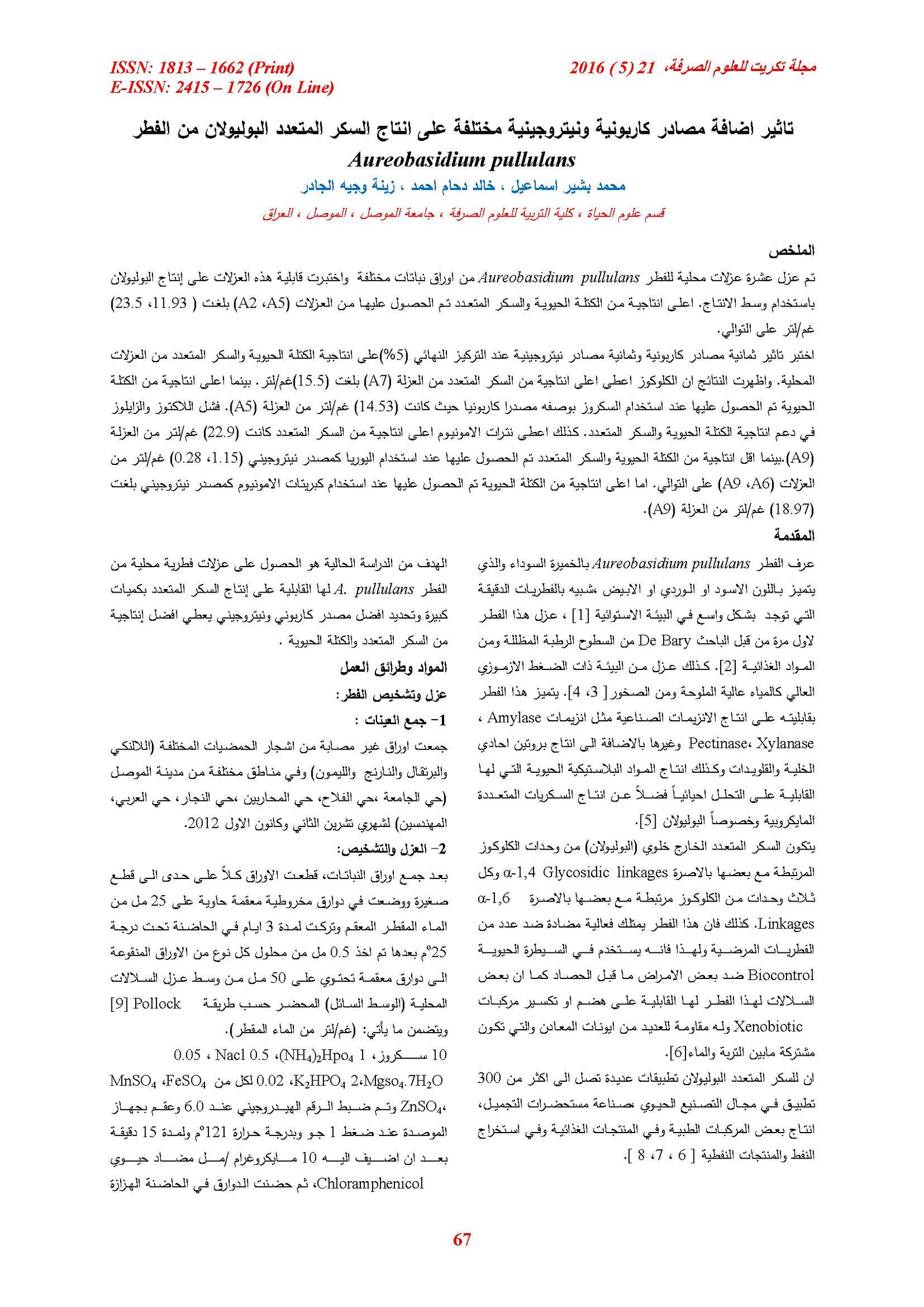Effect of add different carbon and nitrogen source on the pullulan polysaccharide production from fungus Aureobasidium pullulans
Main Article Content
Abstract
Ten local isolates of Aureobasidium pullulans were isolated from different plant leaves. The ability of these isolates for pullulans production using production medium was investigated. The highest production of biomass and pullulans were achieved from isolates (A5, A2)with (11.93, 23.5)g/l respactivily.
The effect of eight carbon and eight nitrogen sources at final concentration (5%) on biomass and pullulan production from local isolates were tested. The results showed that glucose gave maximum production of polysaccharide from isolate (A7) with (15.5g/l).While the highest production of biomass were obtained when sucrose were used as a carbon source with (14.53)g/l from isolate (A5). Lactose and xylose failed to support polysaccharide and biomass production. Also Ammonium nitrate gave highest production of polysaccharide for all isolates tested were (22.9 g/l) from (A9). While the lowest production of polysaccharide and biomass were obtained when urea was used as a nitrogen source(1.15 ,0.28 g/l)from isolates (A6, A9) respectively .The highest production of biomass was obtained in case of using ammonium sulphat as a nitrogen source with (18.97 g/l) from isolate (A9).
Article Details

This work is licensed under a Creative Commons Attribution 4.0 International License.
Tikrit Journal of Pure Science is licensed under the Creative Commons Attribution 4.0 International License, which allows users to copy, create extracts, abstracts, and new works from the article, alter and revise the article, and make commercial use of the article (including reuse and/or resale of the article by commercial entities), provided the user gives appropriate credit (with a link to the formal publication through the relevant DOI), provides a link to the license, indicates if changes were made, and the licensor is not represented as endorsing the use made of the work. The authors hold the copyright for their published work on the Tikrit J. Pure Sci. website, while Tikrit J. Pure Sci. is responsible for appreciate citation of their work, which is released under CC-BY-4.0, enabling the unrestricted use, distribution, and reproduction of an article in any medium, provided that the original work is properly cited.
References
1- Oguzham, P. and Yangilar, F., Pullulan: production and usage in-food industrial .Afric. J. food Sci. Technol, 4(3): 57-63.(2013).
2- Samson, R. A.; Hoekstra, E. S. and Frisvad, J. C.,"Introduction to food and air borne fungi" 7th ed. Centraalbureau voor Schimmel cultures, ultrecht, 150-177.(2004).
3- Urzi, C.; De Leo, F.; Lopasso, C. and Criseo, G., Intra-specific diversity of Aureobasidium pullulans
strains isolated from rocks and other habitats assessed by physiological methods and by random amplified polymorphic DNA (RAPD). J. Microbiol. Methods,36:95-105 .(1999)
4- Gunde-Cimerman, N.; Zalar, P.; DeHoog, G. S. and Plemenitas, A., Hypersaline water in salterns – natural ecological niches for halophilic black yeasts. FEMS Microbiology. Ecol. 32:235-240.(2000).
5- Tsuji, K.; Toyota, N. and Fujita, F., Molded pullulans type resins coated with thermosetting films. Us patent 3:993-840.(1976).
6- Gaur, R.; Singh, R.; Gupta, M. and Gaur, M., Aureobasidium pullulans, an economically important polymorphic yeast with special reference to pullulans. African J. of Biotechnol. 9(47)., 7989-7997.(2010).
7- Leathers, T. D., biotechnological production and applications of pullulan. Appl. Microbial. and Biotechnol. 62:468-473.(2003).
8- Prasongsuk, S.; Sullivan, R. F.;Kuhirun, M.; Eveleigh, D. E. and Punnapayk, H., W., Characterization of Aureobasidium pullulans isolated from airborne spores in thailand. J. of Microbiol. and Biotechnol., 21: 393-398.(2005).
9- Pollock, T. J. ; Thorn, L. and Armentrout, R.W., Isolation of new Aureobasidium strains that produce high-molecular- weight pullulans with reduced pigmentation. Appl. Enviro. Microbiol., 58:877(1992).
12- Ono, K.; Yasuha, N. and Veda, S. I., Effect of pH on pullulan elaboration by Aureobasidium pullulans . Agric. Biol. Chem., 41:2113(1977).
13- Breierova, E.; Gregor, T.; Jursikova, P.; Stratilova, E. and Fisera, M., The role of pullulan and pectin in the uptake of Cd+2 and Ni+2 ions by Aureobasidium pullulans. Annals of Microbiol., 54(3), 247-255 (2004).
14- Lacroix, C. ; LeDuy, A.; Noel, G. and Choplin, L., Effect of pH on the batch fermentation of pullulan from sucrose medium. Biotechnol., Bioeng., 207:202(1985).
15- Wu, S.; Chen, J. and Pan, S., Optimization of fermentation conditions for the production of pullulan by a new strain of Aureobasidiumpullulans isolated from sea mud and its characterization. Carbohydr.Polymer. 87:1696-1700. (2012).
16- Moubasher, H.; Wahsh, S. S.; Abo El-kassem, N., Isolation of Aureobasidium pullulans and the effect of different conditions for pullulanase and pullulans production.Microbiol.Vol.82, No.2, PP.155-161.(2013).
17- Shin, L.; Kim, Y. H.; Lee, K. S.; Kim, Y. N. and Byun, S. M., Production of pullulan by a fed- batch fermentation. Biotechnol. Letts. 9:621-624.(1987).
18- Souw , P. and Deimain A. L., Nutritional studies on xanthan production by Xanthomonas campestris NRRL B-1459. Appl. Environ. Microbiol. 37: 1186-1192.(1979).
19- West T. P.; Reed-Hamer, B., Ability of Aureobasidium pullulans to synthesis pullulan upon selected sources of carbon and nitrogen. Microbios. 67: 117-124.(1991).
20- Cheng, K; Demirci, A. and Catchmark, J. M., Pullulan: Biosynthesis, Production and Applications. Appl. Microbiol. and Biotechnol. 92: 29-44. (2011).
21- LeDuy, A.; Boa, J. M., Enhanced production of pullulans from lactose by adaption and by mixed culture techniques. Can. J. Microbiol. 29: 143-146.(1983).
